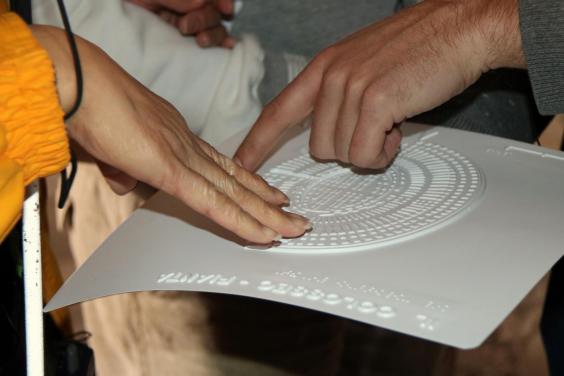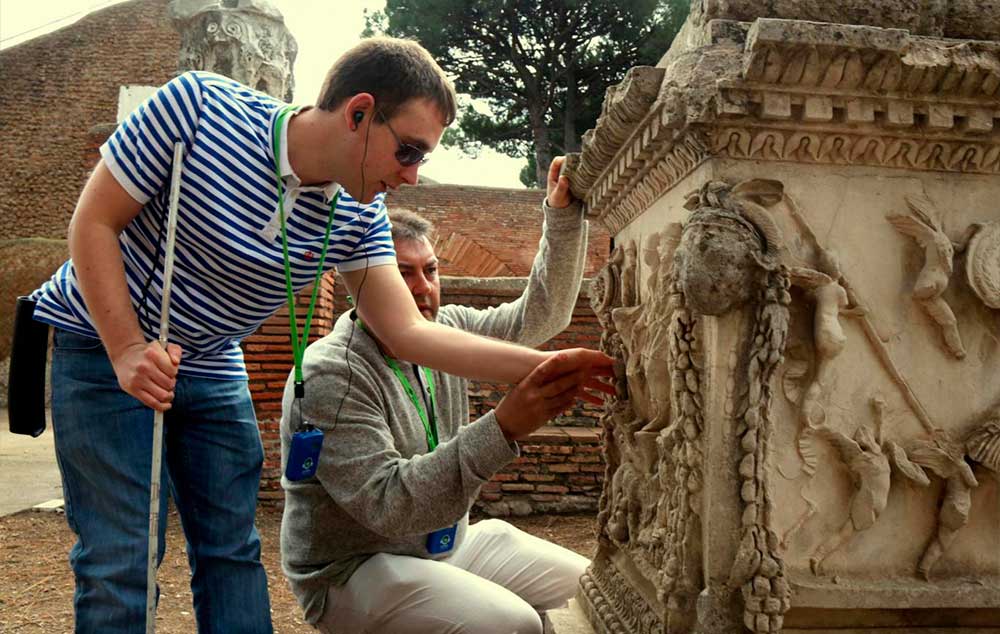I’m standing in the Sistine Chapel at the Vatican in Rome, using a scarf to give my travelling companion an idea of the enormity of God’s buttocks.
“I’m sure He would forgive us,” I say to Sarah, as I indicate, with my ad hoc tape measure, the distance from cheek to cheek. We giggle in the hushed crowd.
Around us, people are staring at Michelangelo’s famous ceiling. The occasional “Oh!” suggests someone else has spotted the controversial backside of the Almighty (as he heads off after separating day and night) too.
But Sarah is blind, so this is my way of giving her a sense of scale, as we take in the most famous fresco in the world.
Rome is a city of iconic images. Most sighted people know what the Colosseum, St Peter’s Basilica and the Trevi Fountain look like. But on this holiday, in which those who are blind or partially sighted are partnered with those who can see, the onus is on the latter to act as their companions’ eyes.
Of course, what you “see” and end up talking about, often depends on the interests of the person you’re partnered with – a coupling that changes every day.
So when Elisa, who works for the US immigration department, is on my arm, and I spot a Bulgari store by the Spanish Steps, we end up admiring – and I end up describing – jewellery. When I’m with Kaukub, who works for West Yorkshire Police, the focus turns to architecture, while student Alice, although interested in the sights, requests I keep an eye out for men too.
 The group inside the Colosseum
The group inside the Colosseum
Our tour manager, Jack, from the specialist company Traveleyes, explains that my role is to be a friend and guide. “You’re not a carer” he says, “although you do need to be a caring person.”
Pre-trip information assures me that I don’t need to be “unusually extrovert” either, but that I should feel comfortable with “friendly banter”.
Normally, I don’t have any difficulty chatting, but it’s a lot more challenging when conversations need to be peppered with instructions.
I’m often mid-flow when it’s time to cross a road or negotiate steps or turnstiles, and by the time I’ve alerted my companion (“Here comes the kerb. Okay, step up now.”) I’ve completely forgotten what I was about to say.
My first descriptive challenge comes at the Trevi Fountain. Alice asks what it looks like; I think I do all right: “Muscular Neptune, rearing sea horses, baroque façade (brilliant white after restoration) and water as blue as a swimming pool.”
But as we walk away, I’m distracted by a shop window and end up muttering with mock disapproval. “What have you seen? Tell me!” Alice cries.
I ask if she wants me to be honest (of course she does), so I whisper that I’ve just spotted a display of penis-shaped pasta.
As Alice hails the rest of the group over, James, who’s 26 but already a Traveleyes veteran, comments on the fun he gets out of experience the world from different perspectives. “When we visited Sorrento in Italy,” he says, “I spent the day with a teenager who described every archaeological ruin as either a burrito or a banana.”
Everyone certainly seems to enjoy themselves. And although those who are visually impaired (the VIs, as they’re familiarly known) pay a bit more for the trip, compared with those who are sighted, who pay considerably less, both seem to benefit.
“A holiday like this gives me independence,” says Laurel, who has limited vision. “It’s nice not to have to rely on my family and friends.”
Sighted traveller Stephen, who has a wonderfully succinct way with words (as I’m labouring over describing the multi-coloured outfits of the Swiss Guards at the Vatican, he takes one glance and says “harlequins”), adds: “We’re never rushed. We’re often given exclusive access and get brilliant guides.”
Our local guide, Manuela, is nothing short of exceptional. She brings 3D models of the main sites, labelled in Braille, encourages five of us to link arms round a column in the pantheon to gauge its size, and gets out her iPhone to play sound effects of cart wheels bumping over cobbles, as we stroll through the ruins of the nearby ancient city of Ostia Antica.
Gradually, I settle into my own role too. I no longer worry if I say “Look!” or “Did you see that?” as that’s what VIs say anyway, and I find I actually enjoy painting pictures of the city around us.
 3D models give blind travellers an overview of sites such as the Colosseum
3D models give blind travellers an overview of sites such as the Colosseum
As James and I cross the street to the Roman forum, I mention the ornate lamp posts and custard-coloured houses with pretty blue shutters.
“Now is that navy blue or baby blue?” James asks cheekily. “And why is there so much security about?”
“Security? I haven’t mentioned security.”
“Oh sorry, I tuned out!” he quips. “I was just taking everything in!”
His comment reminds me of what Elisa said one dinner time: “I tell people I may not have my sight, but I still have my other senses – not to mention common sense.”
It’s why, when we arrive at a restaurant on our last day, and my VI friends suggest we pick a non-smoking table, away from the kids, but in the sunshine – I readily agree, and sit down, without having said a word.
Source: Independent



